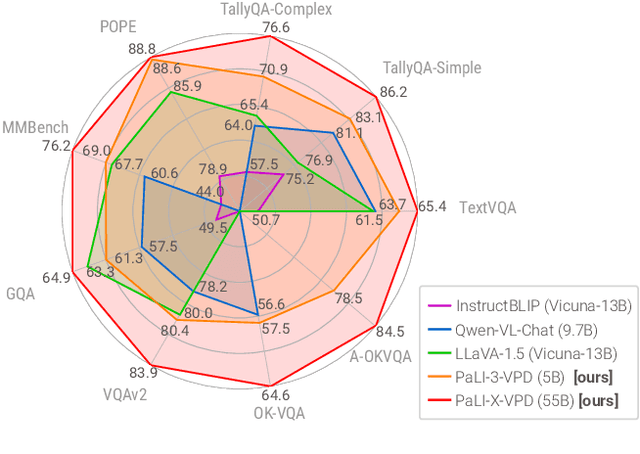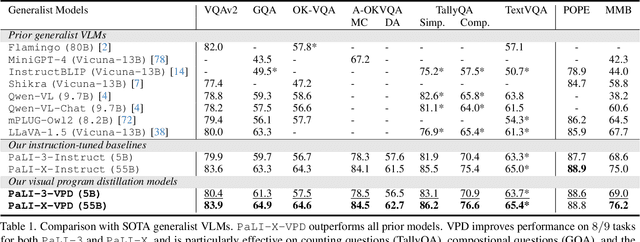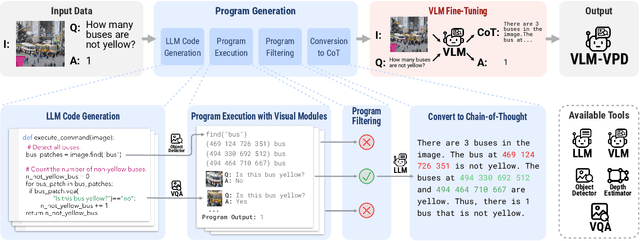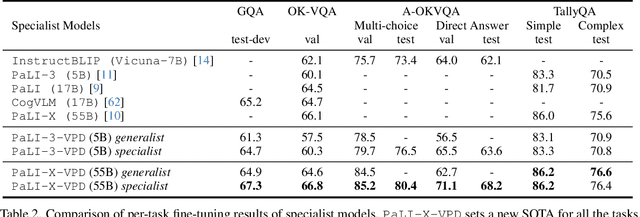Yushi Hu
Decoding-Time Language Model Alignment with Multiple Objectives
Jun 27, 2024



Abstract:Aligning language models (LMs) to human preferences has emerged as a critical pursuit, enabling these models to better serve diverse user needs. Existing methods primarily focus on optimizing LMs for a single reward function, limiting their adaptability to varied objectives. Here, we propose $\textbf{multi-objective decoding (MOD)}$, a decoding-time algorithm that outputs the next token from a linear combination of predictions of all base models, for any given weightings over different objectives. We exploit a common form among a family of $f$-divergence regularized alignment approaches (such as PPO, DPO, and their variants) to identify a closed-form solution by Legendre transform, and derive an efficient decoding strategy. Theoretically, we show why existing approaches can be sub-optimal even in natural settings and obtain optimality guarantees for our method. Empirical results demonstrate the effectiveness of the algorithm. For example, compared to a parameter-merging baseline, MOD achieves 12.8% overall reward improvement when equally optimizing towards $3$ objectives. Moreover, we experiment with MOD on combining three fully-finetuned LLMs of different model sizes, each aimed at different objectives such as safety, coding, and general user preference. Unlike traditional methods that require careful curation of a mixture of datasets to achieve comprehensive improvement, we can quickly experiment with preference weightings using MOD to find the best combination of models. Our best combination reduces toxicity on Toxigen to nearly 0% and achieves 7.9--33.3% improvement across other three metrics ($\textit{i.e.}$, Codex@1, GSM-COT, BBH-COT).
Beyond Thumbs Up/Down: Untangling Challenges of Fine-Grained Feedback for Text-to-Image Generation
Jun 24, 2024Abstract:Human feedback plays a critical role in learning and refining reward models for text-to-image generation, but the optimal form the feedback should take for learning an accurate reward function has not been conclusively established. This paper investigates the effectiveness of fine-grained feedback which captures nuanced distinctions in image quality and prompt-alignment, compared to traditional coarse-grained feedback (for example, thumbs up/down or ranking between a set of options). While fine-grained feedback holds promise, particularly for systems catering to diverse societal preferences, we show that demonstrating its superiority to coarse-grained feedback is not automatic. Through experiments on real and synthetic preference data, we surface the complexities of building effective models due to the interplay of model choice, feedback type, and the alignment between human judgment and computational interpretation. We identify key challenges in eliciting and utilizing fine-grained feedback, prompting a reassessment of its assumed benefits and practicality. Our findings -- e.g., that fine-grained feedback can lead to worse models for a fixed budget, in some settings; however, in controlled settings with known attributes, fine grained rewards can indeed be more helpful -- call for careful consideration of feedback attributes and potentially beckon novel modeling approaches to appropriately unlock the potential value of fine-grained feedback in-the-wild.
Visual Sketchpad: Sketching as a Visual Chain of Thought for Multimodal Language Models
Jun 13, 2024



Abstract:Humans draw to facilitate reasoning: we draw auxiliary lines when solving geometry problems; we mark and circle when reasoning on maps; we use sketches to amplify our ideas and relieve our limited-capacity working memory. However, such actions are missing in current multimodal language models (LMs). Current chain-of-thought and tool-use paradigms only use text as intermediate reasoning steps. In this work, we introduce Sketchpad, a framework that gives multimodal LMs a visual sketchpad and tools to draw on the sketchpad. The LM conducts planning and reasoning according to the visual artifacts it has drawn. Different from prior work, which uses text-to-image models to enable LMs to draw, Sketchpad enables LMs to draw with lines, boxes, marks, etc., which is closer to human sketching and better facilitates reasoning. Sketchpad can also use specialist vision models during the sketching process (e.g., draw bounding boxes with object detection models, draw masks with segmentation models), to further enhance visual perception and reasoning. We experiment with a wide range of math tasks (including geometry, functions, graphs, and chess) and complex visual reasoning tasks. Sketchpad substantially improves performance on all tasks over strong base models with no sketching, yielding an average gain of 12.7% on math tasks, and 8.6% on vision tasks. GPT-4o with Sketchpad sets a new state of the art on all tasks, including V*Bench (80.3%), BLINK spatial reasoning (83.9%), and visual correspondence (80.8%). All codes and data are in https://visualsketchpad.github.io/.
BLINK: Multimodal Large Language Models Can See but Not Perceive
Apr 18, 2024



Abstract:We introduce Blink, a new benchmark for multimodal language models (LLMs) that focuses on core visual perception abilities not found in other evaluations. Most of the Blink tasks can be solved by humans "within a blink" (e.g., relative depth estimation, visual correspondence, forensics detection, and multi-view reasoning). However, we find these perception-demanding tasks cast significant challenges for current multimodal LLMs because they resist mediation through natural language. Blink reformats 14 classic computer vision tasks into 3,807 multiple-choice questions, paired with single or multiple images and visual prompting. While humans get 95.70% accuracy on average, Blink is surprisingly challenging for existing multimodal LLMs: even the best-performing GPT-4V and Gemini achieve accuracies of 51.26% and 45.72%, only 13.17% and 7.63% higher than random guessing, indicating that such perception abilities have not "emerged" yet in recent multimodal LLMs. Our analysis also highlights that specialist CV models could solve these problems much better, suggesting potential pathways for future improvements. We believe Blink will stimulate the community to help multimodal LLMs catch up with human-level visual perception.
Training Language Models to Generate Text with Citations via Fine-grained Rewards
Feb 06, 2024



Abstract:While recent Large Language Models (LLMs) have proven useful in answering user queries, they are prone to hallucination, and their responses often lack credibility due to missing references to reliable sources. An intuitive solution to these issues would be to include in-text citations referring to external documents as evidence. While previous works have directly prompted LLMs to generate in-text citations, their performances are far from satisfactory, especially when it comes to smaller LLMs. In this work, we propose an effective training framework using fine-grained rewards to teach LLMs to generate highly supportive and relevant citations, while ensuring the correctness of their responses. We also conduct a systematic analysis of applying these fine-grained rewards to common LLM training strategies, demonstrating its advantage over conventional practices. We conduct extensive experiments on Question Answering (QA) datasets taken from the ALCE benchmark and validate the model's generalizability using EXPERTQA. On LLaMA-2-7B, the incorporation of fine-grained rewards achieves the best performance among the baselines, even surpassing that of GPT-3.5-turbo.
Visual Program Distillation: Distilling Tools and Programmatic Reasoning into Vision-Language Models
Dec 05, 2023



Abstract:Solving complex visual tasks such as "Who invented the musical instrument on the right?" involves a composition of skills: understanding space, recognizing instruments, and also retrieving prior knowledge. Recent work shows promise by decomposing such tasks using a large language model (LLM) into an executable program that invokes specialized vision models. However, generated programs are error-prone: they omit necessary steps, include spurious ones, and are unable to recover when the specialized models give incorrect outputs. Moreover, they require loading multiple models, incurring high latency and computation costs. We propose Visual Program Distillation (VPD), an instruction tuning framework that produces a vision-language model (VLM) capable of solving complex visual tasks with a single forward pass. VPD distills the reasoning ability of LLMs by using them to sample multiple candidate programs, which are then executed and verified to identify a correct one. It translates each correct program into a language description of the reasoning steps, which are then distilled into a VLM. Extensive experiments show that VPD improves the VLM's ability to count, understand spatial relations, and reason compositionally. Our VPD-trained PaLI-X outperforms all prior VLMs, achieving state-of-the-art performance across complex vision tasks, including MMBench, OK-VQA, A-OKVQA, TallyQA, POPE, and Hateful Memes. An evaluation with human annotators also confirms that VPD improves model response factuality and consistency. Finally, experiments on content moderation demonstrate that VPD is also helpful for adaptation to real-world applications with limited data.
DreamSync: Aligning Text-to-Image Generation with Image Understanding Feedback
Nov 29, 2023



Abstract:Despite their wide-spread success, Text-to-Image models (T2I) still struggle to produce images that are both aesthetically pleasing and faithful to the user's input text. We introduce DreamSync, a model-agnostic training algorithm by design that improves T2I models to be faithful to the text input. DreamSync builds off a recent insight from TIFA's evaluation framework -- that large vision-language models (VLMs) can effectively identify the fine-grained discrepancies between generated images and the text inputs. DreamSync uses this insight to train T2I models without any labeled data; it improves T2I models using its own generations. First, it prompts the model to generate several candidate images for a given input text. Then, it uses two VLMs to select the best generation: a Visual Question Answering model that measures the alignment of generated images to the text, and another that measures the generation's aesthetic quality. After selection, we use LoRA to iteratively finetune the T2I model to guide its generation towards the selected best generations. DreamSync does not need any additional human annotation. model architecture changes, or reinforcement learning. Despite its simplicity, DreamSync improves both the semantic alignment and aesthetic appeal of two diffusion-based T2I models, evidenced by multiple benchmarks (+1.7% on TIFA, +2.9% on DSG1K, +3.4% on VILA aesthetic) and human evaluation.
Davidsonian Scene Graph: Improving Reliability in Fine-grained Evaluation for Text-to-Image Generation
Oct 30, 2023



Abstract:Evaluating text-to-image models is notoriously difficult. A strong recent approach for assessing text-image faithfulness is based on QG/A (question generation and answering), which uses pre-trained foundational models to automatically generate a set of questions and answers from the prompt, and output images are scored based on whether these answers extracted with a visual question answering model are consistent with the prompt-based answers. This kind of evaluation is naturally dependent on the quality of the underlying QG and QA models. We identify and address several reliability challenges in existing QG/A work: (a) QG questions should respect the prompt (avoiding hallucinations, duplications, and omissions) and (b) VQA answers should be consistent (not asserting that there is no motorcycle in an image while also claiming the motorcycle is blue). We address these issues with Davidsonian Scene Graph (DSG), an empirically grounded evaluation framework inspired by formal semantics. DSG is an automatic, graph-based QG/A that is modularly implemented to be adaptable to any QG/A module. DSG produces atomic and unique questions organized in dependency graphs, which (i) ensure appropriate semantic coverage and (ii) sidestep inconsistent answers. With extensive experimentation and human evaluation on a range of model configurations (LLM, VQA, and T2I), we empirically demonstrate that DSG addresses the challenges noted above. Finally, we present DSG-1k, an open-sourced evaluation benchmark that includes 1,060 prompts, covering a wide range of fine-grained semantic categories with a balanced distribution. We release the DSG-1k prompts and the corresponding DSG questions.
Fine-Grained Human Feedback Gives Better Rewards for Language Model Training
Jun 02, 2023Abstract:Language models (LMs) often exhibit undesirable text generation behaviors, including generating false, toxic, or irrelevant outputs. Reinforcement learning from human feedback (RLHF) - where human preference judgments on LM outputs are transformed into a learning signal - has recently shown promise in addressing these issues. However, such holistic feedback conveys limited information on long text outputs; it does not indicate which aspects of the outputs influenced user preference; e.g., which parts contain what type(s) of errors. In this paper, we use fine-grained human feedback (e.g., which sentence is false, which sub-sentence is irrelevant) as an explicit training signal. We introduce Fine-Grained RLHF, a framework that enables training and learning from reward functions that are fine-grained in two respects: (1) density, providing a reward after every segment (e.g., a sentence) is generated; and (2) incorporating multiple reward models associated with different feedback types (e.g., factual incorrectness, irrelevance, and information incompleteness). We conduct experiments on detoxification and long-form question answering to illustrate how learning with such reward functions leads to improved performance, supported by both automatic and human evaluation. Additionally, we show that LM behaviors can be customized using different combinations of fine-grained reward models. We release all data, collected human feedback, and codes at https://FineGrainedRLHF.github.io.
TIFA: Accurate and Interpretable Text-to-Image Faithfulness Evaluation with Question Answering
Mar 28, 2023Abstract:Despite thousands of researchers, engineers, and artists actively working on improving text-to-image generation models, systems often fail to produce images that accurately align with the text inputs. We introduce TIFA (Text-to-Image Faithfulness evaluation with question Answering), an automatic evaluation metric that measures the faithfulness of a generated image to its text input via visual question answering (VQA). Specifically, given a text input, we automatically generate several question-answer pairs using a language model. We calculate image faithfulness by checking whether existing VQA models can answer these questions using the generated image. TIFA is a reference-free metric that allows for fine-grained and interpretable evaluations of generated images. TIFA also has better correlations with human judgments than existing metrics. Based on this approach, we introduce TIFA v1.0, a benchmark consisting of 4K diverse text inputs and 25K questions across 12 categories (object, counting, etc.). We present a comprehensive evaluation of existing text-to-image models using TIFA v1.0 and highlight the limitations and challenges of current models. For instance, we find that current text-to-image models, despite doing well on color and material, still struggle in counting, spatial relations, and composing multiple objects. We hope our benchmark will help carefully measure the research progress in text-to-image synthesis and provide valuable insights for further research.
 Add to Chrome
Add to Chrome Add to Firefox
Add to Firefox Add to Edge
Add to Edge